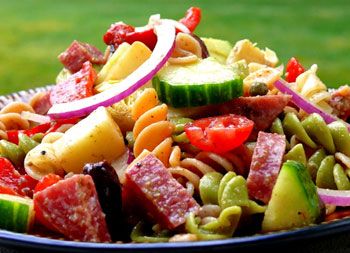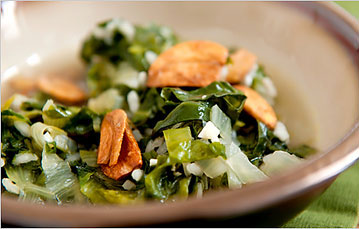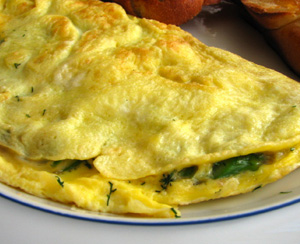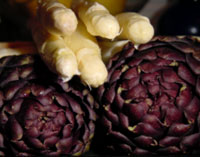 Who doesn't love a good tangy pasta salad? I have tried many, many recipes over the years and I have to say I like the idea of antipasto meets pasta salad.
Who doesn't love a good tangy pasta salad? I have tried many, many recipes over the years and I have to say I like the idea of antipasto meets pasta salad.
Every bite is something different, I love that; crunchy cucumbers, salami, artichoke hearts, kalmata olives and especially the smoked mozzarella. It's quite the yum factor.
This salad is best when made and dressed a day ahead so the flavors can marinate. If you don't have the time to do that, adding a generous splash of red wine vinegar just before serving gives the salad the same bright, tangy flavor.
Make it now or for an upcoming picnic. You will love it.
Spring
Spring
A Reason to Be Bitter in Spring
From the New York Times
 Like radicchio and other bitter, tough greens, escarole can survive the winter in many places and appear early in spring. But unlike radicchio, escarole is inexpensive. And it’s more versatile: it tastes better cooked than does its round, red cousin.
Like radicchio and other bitter, tough greens, escarole can survive the winter in many places and appear early in spring. But unlike radicchio, escarole is inexpensive. And it’s more versatile: it tastes better cooked than does its round, red cousin.
In fact, escarole is at its most appealing when sautéed or braised, as the flavor becomes softer and even a bit buttery. It’s especially excellent with loads of garlic, and this traditional Italian soup — one of my go-to comfort recipes — is a prime example.
Though you might try other bitter vegetables here (watercress, curly endive, even celery come to mind), you definitely want short-grain rice, the kind used for risotto — arborio being the most familiar, though any short-grain rice, including those from Asia, will work well. All have a high starch content, so they turn creamy when they absorb liquid (which, by the way, should be homemade chicken stock, if at all possible). My second choice would be good vegetable or mushroom stock.
Rhubarb. Roasted. Honey-Glazed. Sigh.
 Bemidji’s Natural Choice Farmers Market opened for the season yesterday. I was there with my market bag, filling it with fresh butter lettuce, baby turnips, green onions and beautiful rosy red radishes. Oh, and I can’t forget the homemade bread.
Bemidji’s Natural Choice Farmers Market opened for the season yesterday. I was there with my market bag, filling it with fresh butter lettuce, baby turnips, green onions and beautiful rosy red radishes. Oh, and I can’t forget the homemade bread.
I spotted long, slender stalks of rhubarb, too. I didn’t need to buy that, though. A friend supplied me with several pounds of beautiful rhubarb, one of my favorite vegetables of spring.
Vegetable, you ask? Yes. As Kim Ode, author of the recently published cookbook, “Rhubarb Renaissance,” explained in a class she taught at Byerly’s in St. Louis Park last week, since we are accustomed to using rhubarb in desserts sweetened with sugar, we think of it as a fruit. In fact, it is a vegetable that was first used for medicinal purposes centuries ago.
Spring Omelette
 The addition of fresh herbs breathes life into dishes. Herbs are vibrant, bright and introduce flavor that is so startlingly different from dried herbs that I can never understand recipes that imply they are interchangeable.
The addition of fresh herbs breathes life into dishes. Herbs are vibrant, bright and introduce flavor that is so startlingly different from dried herbs that I can never understand recipes that imply they are interchangeable.
In Italy I learned to make spaghetti with garlic, olive oil, chile flakes and parsley. It wasn't just the color contrast but the lively springiness of the parsley that made this simple dish so wonderful. Likewise sage leaves crisped up in butter or olive oil lend intensity and crunch, a handful of cilantro in a tossed green salad gives it a lemony zing and a sprinkle of chives on smoked salmon adds a delicate, almost sweet oniony flavor.
I have a little herb garden and I do mean little. A harvest of herbs from my window box is roughly equal to a generous garnish, so I have to keep raiding my mother's herb garden and buying herbs if I want to cook with them. Last week I got a chance to try Daregal fresh frozen herbs and found them to be surprisingly convenient and fresh tasting. I made a lovely omelette filled with asparagus and Jarlsberg cheese and a couple of pinches of Daregal frozen dill. This filling combination feels very Scandinavian to me though I have no idea if it really is...
Spring Vegetables
 Typically the arrival of thistle shaped green vegetables such as asparagus and artichokes signal that Spring has sprung. But last week I was seduced into buying some exotic looking white asparagus and violet artichokes, each of which are much more common in Europe than they are here in the states. Fortunately interest in a greater variety of vegetables is growing and so they are getting easier and easier to find. My two sources? Berkley Bowl and Trader Joe's.
Typically the arrival of thistle shaped green vegetables such as asparagus and artichokes signal that Spring has sprung. But last week I was seduced into buying some exotic looking white asparagus and violet artichokes, each of which are much more common in Europe than they are here in the states. Fortunately interest in a greater variety of vegetables is growing and so they are getting easier and easier to find. My two sources? Berkley Bowl and Trader Joe's.
Last week I got a chance to go to Berkley Bowl for the first time. Berkeley Bowl is an independent supermarket that puts the big chains to shame. The produce section is what they are most famous for and it truly is impressive. While not as elegant as the great food halls in London, the variety and volume is way beyond what I'm accustomed to. Prices are moderate, I bought a pound of white asparagus and a four pack of Belgian endive, for a little over two dollars each.
More Articles ...
Welcome to the new One for the Table ...
Our Home Page will be different each time you arrive.
We're sure you'll find something to pique your interest...

